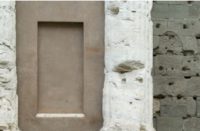
If you missed this year’s World of Concrete in Las Vegas, let me bring you up to date on what is happening in the decorative concrete industry. The decorative all-stars were out in full force and they certainly delivered. The decorative concrete information highway ran straight through Las Vegas, and rumor is it’s headed toward Phoenix, Ariz., in 2010.
You are about to read a recap of two WOC seminars that covered what I feel are two of the most talked-about segments of the decorative concrete industry. After we review these two classes I will take a few minutes to pass along how our industry seems to be faring.
Before we talk about the nuts and bolts here, let me tell you that these guys have been influential in our business on a global level. Their information is beneficial to all contractors who have segued into the decorative side of concrete.
Harris broke down a history of the polishing industry at the start of his presentation that was both informative and fascinating. I had no idea that the polishing we do today originated hundreds of years ago, by hand I might add.
We covered what makes polished concrete so special and unique – it provides an extremely low-maintenance floor without coatings or waxes. The installation process has moved from “wet grinding,” with all its disposal issues, to “dry grinding” with walk-behind and ride-on machines. The class consisted of an overview of what makes a diamond better in relation to “grit” or the size of a tool. The benefit to the contractor can be thousands of dollars in savings when matching up the correct tools to the job.
As determined with a “scratch test,” concrete hardness will help identify the best polishing method. The hardness of the concrete surface will also dictate when a densifier is added and at what step in the grinding/polishing process. These densifiers come in several forms, and Harris spent plenty of time here, but the bottom line is to create a testing method for time-applying the densifiers.
The industry has developed a four-step rating system for concrete shine, which is determined by the stages of grind. This is important when comparing bids and keeping apples to apples. Your competitor could be selling a polished floor at a “Level 1” with less time and money than the “Level 2 or 3” in your bid. As with all decorative types, we learned, a floor sample and the need to visit the site before estimating are important. The introduction of stains and dyes has been huge in increasing the popularity of the polishing process, but picking the right time to apply them is key.
Growth opportunities for the polishing industry are huge in the commercial and municipal markets. Harris warned that this industry could be pricey to enter, so be cautious of your local market and do your homework before jumping in. Great job, guys. Thanks.
Chris Sullivan’s classes (yes, he has two troubleshooting seminars) are always a hit. In fact, many attendees attend parts I and II of the Troubleshooting seminar. This class can be summed up in two words, prevention and education. I must admit that I found myself listening when I should have been taking notes for this column.
This class covers “what-to-do-if” scenarios as well. The seminar started with a big dose of information about avoiding underselling and overperforming our jobs. This can be accomplished by providing accurate job-site samples to bring customer expectations in check. Chris also talked about something else that most of us hear very little about but is so important – compatibility. This is best accomplished by using the same manufacturer from start to finish.
We spent a little time talking about water, the No. 1 enemy of decorative concrete, and how it adversely affects our work. Chris recommends performing a water test over the entire floor to check the porosity of the concrete surface. The porosity, the level of tightness, will play a big part in how the concrete canvas accepts the stain regardless of whether it has a penetrating (acid) or water base. Solvents will always penetrate easier than water-based products. Regardless, less is more when applying stains, dyes and sealers. Light coats are key.
Chris mentioned the importance of developing a system of cleaning, staining and sealing that is followed on each job. This system creates a path from one stage to the other and will help to reveal a problematic situation and what to do to move past it. Many little tips and trade secrets were discussed, including a quick fix with acrylic spray paint that can be found at most hardware stores. We also received a word of caution that the last person to touch a problem job owns it.
If you ever find yourself asking why your sealer does what it does, than be sure to attend one of Chris’s classes on troubleshooting decorative concrete. By the way, Chris writes an article each issue for Concrete Decor called “Trowel and Error.” Good job, Chris.
Finally, the local economy
Plenty of daily information concerning the economy is available these days, and it seems everyone is an economist. Yes, things have and are correcting all over. Yes, some folks are concerned for their future and credit is less available then it once was – but.
Economy experts trying to predict the future of your business is like a weatherman in New Jersey forecasting for the West Coast. My point is this: Your economy is the level of calls for new business that you are experiencing at this time. If you have work on your books, then your earnings have a good shot at being steady. All areas are seeing different levels of calls for new work, so stay true to marketing your business.
















